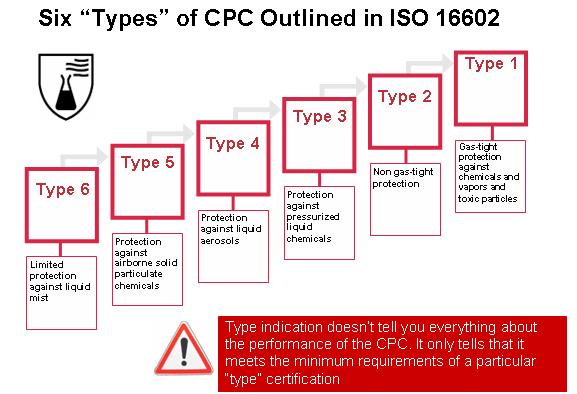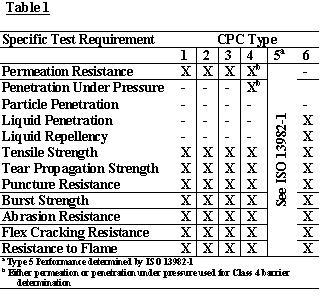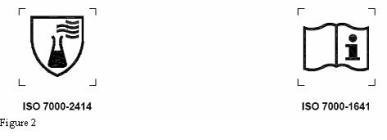
How ISO 16602 Can Assist the Safety Professional
Although only introduced in 2007, ISO 16602 is already recognized and accepted internationally. It is clear that ISO 16602 will become the common global language for expressing CPC performance.
- By James P. Ziegler, Susan Lovasic
- Aug 01, 2009
 Currently in North America there is no comprehensive standard for assessing the performance of chemical protective clothing for workers facing chemical hazards in industrial situations. Safety professionals, who bear responsibility for the selection of chemical protective clothing (CPC), must rely upon manufacturer’s claims to select the appropriate garments. The performance of chemical protective clothing can vary by manufacturer. There is no established means to compare the performance of garments from one manufacturer to the next. Nor is there a common way to describe the overall performance of the protective ensemble or the performance of the ensemble's components against different chemical threats. ISO 16602 provides an objective means of defining the performance of chemical protective apparel worn by workers in situations involving potential chemical hazards.
Currently in North America there is no comprehensive standard for assessing the performance of chemical protective clothing for workers facing chemical hazards in industrial situations. Safety professionals, who bear responsibility for the selection of chemical protective clothing (CPC), must rely upon manufacturer’s claims to select the appropriate garments. The performance of chemical protective clothing can vary by manufacturer. There is no established means to compare the performance of garments from one manufacturer to the next. Nor is there a common way to describe the overall performance of the protective ensemble or the performance of the ensemble's components against different chemical threats. ISO 16602 provides an objective means of defining the performance of chemical protective apparel worn by workers in situations involving potential chemical hazards.
Definition
ISO 16602 is an international standard for classifying chemical protective clothing performance. It is a tool to help safety and occupational health professionals select appropriate chemical protective clothing.
 Background
Background
Chemical protective garments are available in a wide variety of fabrics and designs. The options are intended to provide protection ranging from chemical vapors and gases, to liquid splash, spray or mist, and to particles and aerosols. Unlike other forms of personal protective equipment (PPE) the performance of chemical protective clothing is not highly regulated in the United States or Canada. Some standards exist for hazardous materials emergencies, but little regulation exists regarding routine industrial applications. This void in recognized standards for industrial applications can lead to a complex and potentially confusing environment for those who must select the appropriate apparel for a given hazard or application.
Established by the multi-national International Organization for Standardization (ISO), the requirements outlined in ISO 16602 provide a common language for chemical protective clothing performance. Although only introduced in 2007, ISO 16602 is already recognized and accepted internationally. It is clear that ISO 16602 will become the common global language for expressing CPC performance.
Description
"[ISO 16602] addresses the range of general, industrial chemical protective clothing by designating specific design types and providing classification of clothing, material, and component performance. This international standard is intended to provide comprehensive requirements for the performance classification and labeling of chemical protective clothing." -- ISO 16602:2007(E)
The common global classification system and the standard presentation of the performance data that ISO 16602 provides helps to simplify the selection of chemical protective apparel by safety & occupational health professionals. ISO 16602 provides a standard presentation of the performance data. This standard format allows objective evaluation and comparison of CPC performance among possible options, instead of just relying upon vendors' claims.
The performance requirements defined by ISO 16602 are based on results obtained from existing standard test methods. ISO 16602 permits a range of performance levels for a series of key properties, but also establishes a minimum level of performance for each major type of hazard.
For companies engaged in the same work tasks in different parts of the world and without access to the same CPC, the ISO 16602 description of CPC performance provides a common description that can be used to select the appropriate, locally available CPC. Also, if a specific CPC selection fails to perform as intended in the work environment, the objective measurements provide a means to select higher performing garments.
Selection of Chemical Protective Clothing
The selection of appropriate chemical protective clothing depends upon an accurate hazard assessment. The nature of the chemical hazard, the work activity, and the environment in which the work is being performed must be matched by the fabric, seam, and design of the protective clothing. If the worker is not adequately protected against the hazard he/she may face, the worker could be injured. Conversely, clothing that overprotects can impose unnecessary burdens on the worker, such as heat stress, lack of vision, restricted mobility, and increased physical exertion, as well as higher purchasing costs for the employer.
Hazard Assessment
The following questions are the core of a hazard assessment for CPC. Additional information may be needed to select other PPE, such as respirators. These questions focus on the task, the surroundings, the chemical, and hazards beyond chemical exposure.
The Task
What task is being performed?
- What is the expected duration of the work task?
- What is the potential amount of chemical exposure?
- What is the potential duration of the chemical exposure?
- What OSHA or EPA regulations address the PPE selection?
Has this task been performed in the past?
- What CPC was used?
- Was that CPC appropriate, or are changes needed?
The Surroundings
What is the work environment?
- Can the garment be damaged (torn, punctured, etc.)?
- Does the workspace restrict the design or configuration of the PPE?
- From what direction will the exposure come?
The Chemical
What is the substance?
- Is it a single chemical or a mixture?
- What is the chemical name and Chemical Abstracts Services (CAS) Registry Number?
- Is there a Material Safety Data Sheet (MSDS) available for this material?
What is the physical state of the substance?
- Will the chemical be a solid, liquid, or gas when the worker is potentially exposed?
- Is the chemical solid, liquid, or gas at room temperature?
How is the substance a hazard?
- Is it poisonous by inhalation, ingested, or skin absorption?
- Is it an asphyxiant, corrosive, or an irritant?
- Is it an allergen, carcinogen, or mutagen?
- Are the effects immediate (acute) or chronic?
- What are the signs and symptoms of exposure?
It's important to remember that ISO 16602 sets the minimum requirements for chemical protective clothing. Every work situation is unique, and ISO 16602 does not consider other hazards that may be present in the work environment. Safety and occupational health professionals will also need to consider hazards specific to their work conditions, including:
- extreme heat or cold
- ionizing radiation
- potentially flammable or explosive atmospheres
- hot or extremely cold liquids or surfaces
- asphyxiating atmospheres and confined spaces
- puncture and abrasion hazards from rough surfaces; falling debris; slipping; falling; unsure footing
- visibility -– either the need to be seen or not to be seen
ISO 16602 focuses on chemical hazards and protective clothing. The work situation may likely require additional forms of PPE, such as footwear, gloves, face protection, and respirators. There are specific guidelines for choosing those forms of PPE outside of ISO 16602. But when evaluating protective clothing performance under ISO 16602, gloves, footwear, and respirators must be included in the whole garment testing. Be sure to validate that the other PPE you use works properly with the CPC you select.
Types
The ISO 16602 standard is based upon a system of Types and Classes. Chemical protective clothing is categorized into one of six different Types. The garment Type designation is based upon the physical state of the hazard (Figure 1).
The requirements for each Type entail testing of the entire garment and of individual components. The whole garment tests vary according to the hazard defined by that Type. In these whole garment tests, human subjects wear the test garment and accompanying PPE such as gloves, boots and respirators that would be worn during actual work activities. The test subjects perform a series of movements that simulate actual work activities while being exposed to non-toxic test chemicals in an enclosed chamber. The movements and simulated exposure validate the performance of the entire ensemble against this type of chemical threat. These Type tests do not use hazardous chemicals in the exposure.
An example is the Type 3 whole garment test, during which test subjects march, while turning slowly, in front of high-pressure, high-volume liquid nozzles with exaggerated arm movements. After that exposure, the outer test protective garment is opened and an inner indicator garment is checked for evidence of liquid penetration. Additional tests are conducted on the garment components to qualify performance against the specific chemical challenge and the physical demands of the task and work surroundings.

Figure 1
NOTE: Do not assume that the terms "gas-tight" and "liquid-tight" refer to an absolute barrier performance. They oversimplify the level of barrier provided by such garments. Instead, these terms should be considered as "vapor-protective" and "liquid-protective," respectively.
Classes
Each of the six Types has requirements for various mechanical, barrier, and basic flammability properties. Barrier to the specific chemical hazards, mechanical durability and ease of ignition of the garment materials and components are assessed with lab tests. The results of these barrier and mechanical durability tests fall into a unique performance "Class." Different combinations of barrier and durability tests are specified under each Type. For each Type, a minimum performance Class is required for each of the tests specified under that Type (Table 1). A higher Class denotes a higher level of performance.
The flammability test employed in ISO 16602 is not intended to qualify an ensemble as suitable for protection against heat and flame hazards. The flammability requirements in ISO 16602 establish a minimum performance level of flame spread once the material is ignited. Evaluation of chemical protective clothing for heat and flame protection is outside the scope of ISO 16602.
For applications such as hazmat response, the Type and Class system provides a basis for setting high-level performance specifications based on the ISO 16602 system. The combination of whole garment and component testing ensures the sum of the parts is able to provide the appropriate protection.

Table 1
Applying ISO 16602
Consider the task of unloading a tank truck containing a hazardous liquid under pressure. This activity would likely require a Type 3 garment for protection against the pressurized liquid. This could be a one-piece coverall or a two-piece suit, with or without hood or visor, with or without boot-socks. The Type 3 whole garment jet test would demonstrate the liquid-penetration resistance of the ensemble and the performance of the connections between the garment, gloves, boots, and respirator. The chemical barrier performance of the suit material and components would be determined with permeation tests using the specific chemical of interest. The mechanical durability of the suit against the rigors of the job would be assessed with the other laboratory tests. The hazard assessment and experience of the safety or occupational health professional would lead to the selection of a garment with a specific performance Class in each of the barrier and mechanical tests.
Another example can be found in sanding a surface that is coated with lead-based paint. For protection against airborne hazardous particles, a Type 5 ensemble would be the obvious choice, barring any other hazard or complications. Most likely, the garment would be one-piece coverall with attached hood, but nothing in ISO 16602 precludes a multiple-piece ensemble, such as a separate jacket, hood, and pants. ISO 16602 does not specify the design of the ensemble; it specifies the level of performance. In the case of Type 5, the leakage of particles into the ensemble is measured while the garment is worn by a test subject who is exercising in a chamber filled with non-hazardous salt particles of a small, but uniform size. And, as with the previous case, the nature of the work task will determine the "Class" of mechanical durability required for the work activity and environment.
Labeling
ISO 16602 also sets minimum requirements for garment labeling and documentation. Permanently attached labels for chemical protective clothing should include the manufacturer's contact information, the ISO 16602 Type, the date of manufacture, size, and care instructions. The label can include pictograms taken from ISO 7000, such as those shown below in Figure 2, which indicate that the protective clothing is for hazardous chemicals and that separate manufacturer's instructions are available.
With each suit, the manufacturer should provide complete instructions, including safety considerations, limitations, and user instructions, as well as inspection, warranty, and maintenance information. Because third-party certification is not required with ISO 16602, the safety or occupational health professional should request validation reports from the garment manufacturer for all performance claims made for the CPC.

Conclusion
Our goal is to provide objective information to help safety and occupational health professionals choose the appropriate chemical protective clothing for their hazards. ISO 16602 provides a standard system to test, classify, and label chemical protective apparel products. In addition, ISO 16602 designates minimum performance levels for six Types of chemical hazards.
To learn more about ISO 16602 compliant chemical protective garments and how to obtain them, please contact DuPont Personal Protection Customer Service at 1-800-931-3456.
About the Authors
Susan Lovasic is Global Regulatory Affairs Manager—DuPont Personal Protection. Since 1996, her research has focused on protective apparel applications for chemical, biological, thermal, and fire threats. She holds four U.S. patents associated with materials used for fire/thermal protection and is an active member of the NFPA FAE-HAZ and ASTM F23 Committees.
DuPont™ SafeSPEC™ (www.safespec.dupont.com) provides the most extensive permeation chemical database and offers a Product Selector tool to help you find the best CPC, including garments certified to NFPA 1991, 1992, and 1994, for your chemicals of concern and workplace hazard scenarios.